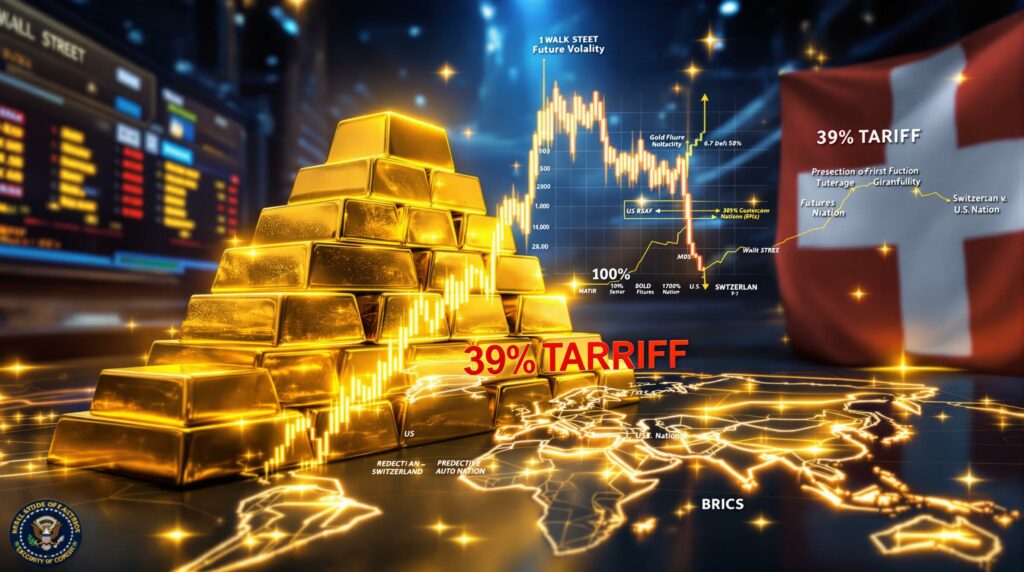US Gold Tariffs: Shaking the Foundations of Global Markets
In an unexpected development that has sent shockwaves through precious metals markets worldwide, the US administration recently announced substantial tariffs on gold imports from Switzerland. This decision has triggered significant market volatility, raised questions about the future of global gold trading, and potentially signals deeper shifts in the international monetary system.
What Are the US Gold Tariffs and Why Were They Implemented?
The recent implementation of gold tariffs by the US administration represents one of the most significant interventions in the precious metals market in recent memory. These measures have sent ripples through global financial markets and created uncertainty for traders and investors alike.
The Surprise Tariff Announcement
In a move that caught markets off guard, the US administration announced a 39% tariff on gold bars imported from Switzerland. The announcement came without warning, creating immediate confusion among market participants who had long operated under the assumption that gold, as a monetary metal, would remain exempt from such tariffs market impact.
US Customs and Border Protection quickly clarified that 1-kilogram and 100-ounce gold bars specifically would be subject to these new levies. The sudden nature of this announcement triggered immediate market reactions, with gold futures briefly surging to record gold highs as traders scrambled to assess the implications.
In an attempt to control the narrative, the White House subsequently indicated plans to issue an executive order to address what it termed "misinformation" about the tariffs. This back-and-forth communication only served to intensify market uncertainty.
Scope of the Gold Tariffs
While initially appearing targeted specifically at Swiss refineries, industry experts now suggest the tariffs could potentially apply more broadly. The Swiss Precious Metals Association has noted that the tariffs could apply to all 1-kilogram and 100-ounce cast bars imported to the USA, regardless of origin.
Significant uncertainty remains about whether 400-ounce bars, which represent London's standard for institutional trading, will face similar tariffs. This question is particularly critical given the substantial volume of gold that moves through the London market.
Switzerland, as the world's largest gold refiner, stands to be significantly impacted by these measures. Swiss refineries process approximately 70% of the world's gold annually, transforming raw gold into the high-purity bars preferred by institutional investors and central banks.
Industry Insight: "The impact on Switzerland could be substantial given their dominant position in global gold refining. These tariffs effectively place a premium on domestically refined gold that could reshape global supply chains," notes a prominent industry analyst tracking the development.
How Have Gold Markets Responded to the Tariff News?
The gold market's reaction to the tariff announcement has been dramatic, revealing both immediate price impacts and deeper structural shifts in how gold is traded globally.
Immediate Market Reaction
Following the tariff announcement, gold futures surged to an all-time closing high of $3,491.30, reflecting both panic buying and strategic positioning by market participants. Prices subsequently retreated approximately $30 after the White House statement about forthcoming clarification, demonstrating the market's hypersensitivity to policy signals.
Trading volume spiked dramatically in the hours following the announcement, with some exchanges reporting activity levels 300% above normal. This surge in trading indicates both heightened market concern and opportunity-seeking behavior by sophisticated market participants.
Perhaps most tellingly, industry participants reported physical gold shipments "freezing up" in response to the news. With uncertainty about how tariffs would be applied to in-transit shipments, many traders opted to halt movements until greater clarity emerged, according to reports from Reuters.
Trading Pattern Changes
One of the most significant developments has been a substantial increase in alternative trading mechanisms that allow participants to negotiate set prices outside regular market volatility. These include:
- Block trades: Large-volume transactions negotiated privately between parties
- Exchange for Physical (EFP) transactions: Converting futures positions to physical delivery
- Exchange for Risk (EFR) transactions: Moving exposure between markets while maintaining similar risk profiles
These mechanisms have seen dramatic upticks in usage, with EFP transactions (futures US to London OTC) and EFR transactions (London OTC back to COMEX) increasing substantially. This pattern suggests market participants are actively seeking ways to manage risk and maintain liquidity amid heightened uncertainty.
The growth in these alternative trading mechanisms points to a potential fragmentation in how gold is priced and traded globally—a development with long-term implications for market structure.
What Are the Potential Global Implications of US Gold Tariffs?
The implementation of gold tariffs by the US represents more than just a trade policy decision—it potentially signals a fundamental shift in how gold functions within the global financial system.
Reshaping Global Gold Flows
The tariffs could accelerate the fragmentation of the global gold market into regional pricing systems, each with its own supply-demand dynamics and pricing mechanisms. This would represent a significant departure from the relatively unified global gold market that has existed for decades.
Physical gold movement patterns may shift away from the traditional US-London axis that has long dominated global gold trading. New routes and relationships could emerge, potentially favoring markets in Asia and the Middle East that have been developing gold trading infrastructure.
This development may accelerate the establishment of alternative trading hubs, particularly in BRICS nations that have explicitly stated their interest in gold safe haven insights. Countries like China, Russia, and India have been expanding their gold reserves significantly and developing domestic gold markets.
The potential for pricing disparities between different regional markets could create arbitrage opportunities for sophisticated traders while increasing complexity for traditional investors.
Impact on Market Infrastructure
The smooth functioning of the US futures contract market could face challenges if physical delivery becomes more complex or costly. The relationship between COMEX (US) and LBMA (London) markets, which has long provided liquidity and price discovery, may need to adapt to new realities.
Gold ETFs and similar investment vehicles, which rely on the efficient movement of physical gold to back their shares, could face liquidity concerns or premium/discount issues if physical gold becomes more difficult to transport or store in certain jurisdictions.
The metal position (MP) trade—a sophisticated strategy involving the simultaneous trading of gold in different markets to capture price differentials—may become more difficult to execute, potentially reducing market efficiency.
Market Insight: "The gold market has operated on a global basis for centuries. These tariffs could effectively create a two-tier system where gold in certain locations trades at a premium to others, fundamentally changing how price discovery works," observes a senior precious metals strategist.
Geopolitical Considerations
The timing of these tariffs aligns with broader currency and trade realignments globally, suggesting they may be part of a larger strategic repositioning rather than an isolated trade measure.
Some analysts speculate the move could represent a strategic effort to increase domestic gold production and retention, potentially part of a broader effort to strengthen national monetary security.
The tariffs may alternatively function as a negotiation tactic to address trade imbalances with Switzerland and other trading partners, with gold serving as a high-profile bargaining chip.
There are potential connections to ongoing discussions about gold's role in monetary systems, particularly as countries explore alternatives to dollar-denominated trade and reserve holdings.
How Might These Tariffs Affect Physical Gold Deliveries?
The movement of physical gold between markets represents the foundation of the global gold trading system. Any disruption to these flows could have far-reaching implications for market functioning.
Recent Trends in Physical Gold Movement
Prior to the tariff announcement, physical gold deliveries on COMEX had been experiencing a significant increase throughout 2024-2025. Record deliveries of 68,000 contracts in April and 75,000 in February represented historical highs, demonstrating unusual demand for physical settlement rather than cash settlement.
Even traditionally slower months like January (22,000 contracts) and July (12,000 contracts) saw substantial physical deliveries, further confirming the trend toward physical metal preference.
This unusual pattern had already caught the attention of market analysts, with some suggesting it indicated growing institutional preference for holding physical gold rather than paper contracts or other financial instruments during a period of heightened economic uncertainty.
Potential Delivery Disruptions
The newly implemented US gold tariffs could significantly impact the cost and logistics of physical gold movement, potentially creating a 39% price differential between domestic and imported gold of the same quality and weight.
This situation may create incentives for alternative delivery mechanisms outside traditional channels, potentially including:
- Increased use of bonded warehouses and free trade zones
- Development of swap arrangements to minimize cross-border movements
- Growth in synthetic exposure products that don't require physical delivery
- Expansion of physical delivery in non-US locations
A premium pricing structure for domestically refined gold could emerge, creating potential opportunities for US mining operations and refineries to expand capacity and capture market share.
The development of new refining capacity within the US becomes economically viable under these circumstances, potentially reversing the long-term trend of refining consolidation in Switzerland and other locations.
What Does This Mean for Gold Investors and Traders?
For those with exposure to gold markets, whether through physical holdings, futures contracts, or mining equities, the tariff situation creates both challenges and opportunities that require careful navigation.
Short-Term Considerations
Investors should expect continued price volatility until policy clarification is provided through the promised executive order. This volatility may create tactical trading opportunities for those able to react quickly to developments.
Market participants should closely monitor official announcements from the White House regarding the executive order, as these will provide critical clarity about which products are affected and how implementation will proceed.
Changes in trading patterns, particularly in alternative transaction types like EFPs and EFRs, may provide early signals about how the market is adapting to the new reality and where liquidity is concentrating.
Investors should be particularly aware of potential premium differences between different gold products and locations, as these could affect the relative value of various gold-related investments.
Long-Term Strategic Implications
Longer-term investors may need to consider the possibility of a more regionalized gold market structure, with different pricing dynamics in various parts of the world. This could affect optimal allocation strategies between different types of gold exposure.
A comprehensive evaluation of exposure to different gold products and their potential tariff vulnerability is advisable, particularly for institutional investors with substantial positions.
Developments in domestic US gold production and refining capacity bear watching, as companies positioned to serve the US market without tariff exposure could benefit significantly.
Gold's evolving role in the broader context of currency and trade realignments suggests maintaining some exposure to physical gold or gold equivalents may be prudent for those concerned about monetary system stability amid the ongoing gold market surge.
Investment Insight: "Diversification across different forms of gold exposure—physical, mining equities, royalty companies, and futures—becomes even more important in a fragmented market environment. Each may respond differently to the evolving tariff situation," advises a portfolio manager specializing in precious metals.
How Does This Connect to Broader Economic Trends?
The gold tariff situation does not exist in isolation but connects to fundamental shifts in global monetary arrangements and investment behaviors.
Gold's Role in Changing Monetary Systems
There are growing discussions about gold potentially serving as backing for currencies or digital alternatives, moving beyond its traditional role as a non-yielding reserve asset. These conversations have intensified as various countries explore alternatives to dollar-denominated trade.
The transition from traditional fiat systems to various forms of digital currencies continues to evolve, with gold potentially serving as a bridge between established and emerging monetary frameworks.
Intriguingly, there appears to be growing interest from cryptocurrency entities in gold backing. Reports suggest major cryptocurrency players like Tether may be acquiring significant stakes in gold-related assets, potentially reflecting a desire to create more tangible backing for digital currencies.
These developments align with gold's traditional function as a "riskless asset" during monetary transitions—a role it has played during numerous currency regime changes throughout history.
Market Correlations and Hedging Behaviors
Gold prices have increasingly tracked "real inflation" as experienced by consumers rather than official CPI figures, suggesting the market may be pricing in monetary concerns beyond those reflected in government statistics.
A fascinating relationship has developed between cryptocurrency and gold markets, with traders moving between these assets depending on perceived risk and opportunity. Both assets share characteristics as alternatives to traditional financial system exposure.
Institutional investors appear to be increasing gold allocations amid currency uncertainties, with some major endowments and pension funds reporting higher target allocations to precious metals than historical norms.
Central banks globally have been on a gold buying spree, with record purchases in recent years suggesting official sector concern about currency stability and a desire to diversify reserves away from traditional fiat currencies, as detailed in analysis from The Guardian.
What Should We Watch for Next?
As this situation continues to evolve, several key developments will provide signals about the long-term implications for gold markets and investments.
Key Policy Developments
The forthcoming White House executive order clarifying the tariff situation represents the most immediate catalyst for market movement. Its specific language regarding product classifications, implementation timelines, and potential exemptions will significantly impact market dynamics.
Market participants should watch for potential expansion or contraction of tariffs to other countries beyond Switzerland, as this would signal whether the measure is targeted specifically at Swiss refiners or represents a broader policy shift.
Responses from affected trading partners and international organizations like the WTO could escalate or de-escalate the situation, potentially leading to negotiated solutions or further trade measures.
Statements from major market participants about operational adjustments will provide insight into how the industry is adapting to the new landscape and where new opportunities may emerge.
Market Indicators
Changes in physical delivery patterns on COMEX and other exchanges will reveal how the tariffs are affecting the movement of gold between markets and whether alternative delivery mechanisms are emerging.
The development of price premiums or discounts between different markets could create arbitrage opportunities while signaling the degree of market fragmentation occurring.
Shifts in trading volume between different contract types and exchanges may indicate where liquidity is concentrating and which trading venues are gaining or losing market share.
Announcements from refiners about production or distribution changes will provide early signals about supply chain adaptations and potential investment opportunities in emerging refining locations.
FAQs About US Gold Tariffs
Will these tariffs affect consumer gold prices?
While institutional trading represents the bulk of gold movement, tariffs could eventually impact retail prices if they remain in place long-term. The degree of impact would depend on how much of the tariff cost is absorbed throughout the supply chain versus passed to end consumers.
Small-denomination products like coins and small bars may see less immediate impact if they're exempted from the tariffs or if they're already produced domestically. However, if the tariffs remain in place long-term, even these products could see price increases as overall gold premiums adjust.
Could this lead to gold shortages in the US?
A complete shortage is unlikely, but the tariffs could create temporary supply disruptions and potentially lead to premium pricing for certain products. The US has domestic gold production that could increase in response to higher prices.
Annual US gold mine production currently stands at approximately 180-190 metric tons, representing only about 6% of global output. While this is insufficient to meet total US demand, it provides a baseline domestic supply that could expand under favorable price conditions.
How might this affect gold mining stocks?
US-based gold miners could potentially benefit if the tariffs remain in place, as domestically produced gold would avoid the tariffs. Companies with significant US operations might see improved margins compared to those relying on imported refined products.
Investors should evaluate mining companies based on:
- Geographic distribution of operations
- Production costs relative to current and projected gold prices
- Refining arrangements and delivery locations
- Hedging strategies that might limit upside from price increases
Is this connected to central bank gold buying?
While speculative, some analysts have suggested the tariffs could be related to strategic gold acquisition by the Federal Reserve or Treasury. The substantial increase in physical deliveries on COMEX has fueled theories about official sector involvement.
Global central banks added approximately 1,136 tons of gold to their reserves in the most recent reported year, the highest level of annual purchases in over five decades. This trend reflects growing concern about currency stability and diversification away from traditional reserve currencies.
How does this relate to BRICS currency developments?
The timing coincides with ongoing discussions among BRICS nations about alternative payment systems and currency arrangements. Gold tariffs could potentially accelerate the development of separate trading systems for precious metals aligned with these currency blocs.
BRICS nations collectively hold over 5,000 tons of gold in official reserves, with Russia and China being particularly active buyers in recent years. These holdings could potentially support alternative currency arrangements or trade settlement mechanisms being discussed within the bloc.
While uncertainty remains, the latest gold price forecast suggests that these tariffs will continue to influence market dynamics throughout 2025.
Disclaimer: This article contains analysis of complex market developments with significant uncertainty. The information provided represents current understanding of evolving situations and should not be considered investment advice. Readers should consult with qualified financial professionals before making investment decisions based on tariff developments.
Looking to Capitalize on the Next Major Mineral Discovery?
Stay ahead of the market with Discovery Alert's proprietary Discovery IQ model, which instantly notifies investors about significant ASX mineral discoveries and transforms complex data into actionable insights. Visit our dedicated discoveries page to understand why major mineral discoveries can lead to substantial market returns and begin your 30-day free trial today.




